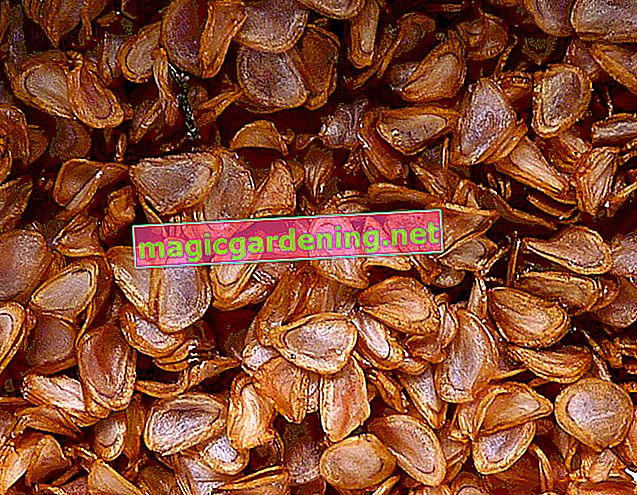
the essentials in brief
- The marbled stink bug is 15 mm long, marbled ocher and has white and black ringed antennae.
- The stink bug is harmful to fruit and leaves because it sucks off the sap. The resulting necroses and cripples make fruits inedible.
- So far there are no control agents. Because the pests stink on contact, they are caught in a glass and carried out of the house.
Marbled stink bug in portrait - wanted poster

For many hobby gardeners, the marbled stink bug is still a blank slate. Loud media complaints from fruit growers in European infested areas such as Switzerland and Liechtenstein are ringing the alarm bells. In the course of an explosive multiplication and spreading, the appearance of the unfriendly newcomer in the garden and house should be known. The following overview summarizes the criteria by which you can recognize a stink beetle:
also read
- The gray garden bug: pest or beneficial insect?
- Where can I find ideas for a new garden path?
- Pulling a plum tree: all you need to know at a glance
| Marbled stink bug | |
|---|---|
| body length | 12-17 mm |
| body shape | leaf-shaped flattened |
| colour | marbled ocher with black dots |
| wing | crystal clear with vertical stripes |
| legs | ocher-colored, six-legged |
| bottom | pale yellow, dotted black on the sides |
| scientific name | Halyomorpha halys |
| origin | East asia |
| Common names | Stink beetle, stink bug |
Has this profile aroused your interest in more detailed information? Then please read on. Important questions about appearance and properties receive a comprehensible answer based on the current knowledge (as of May 2020):
Are there any special identifying features?
The long antennae on the head are a striking distinguishing feature of a marbled stink bug. These are composed of five segments with a dark base color and white stripes. It is characterized by black and white spots on the edge of the rear half of the leaf-shaped body. At the rear end of the body is the thin-skinned, transparent part of the wings, characterized by black lines. Furthermore, a label with a row of several orange calluses can be seen between the wings. This row of points removes any last doubts about the species affiliation.
What Makes Marbled Stink Bugs So Dangerous?

The marbled stink bug has more than 300 host plants in its sights worldwide, including more than 150 different plant species in Europe. The vacuum cleaners cause the greatest damage in fruit crops with crop failures of up to 100 percent. Fruit growers and hobby gardeners are helplessly at the mercy of the introduced harmful organism. The tendency of winged invaders to break into houses and apartments in order to hibernate is not dangerous, but extremely annoying. If you get too close to the pests, they give off a bad smell.
How do stink bugs live and multiply?
Stink bugs hibernate as full adult insects, preferably in a protected, heated environment. When the thermometer exceeds 10 degrees in spring, stink bugs rub their hibernation out of their complex eyes and become active. Famished, they look for suitable host plants in order to fortify themselves on the sap for a few weeks. The mating season begins in mid-May. Mated females lay the eggs in small packets on the underside of the leaves. Amazingly, there are usually exactly 28 eggs in each clutch. Until July, the female bugs place several egg packages and thus have up to 450 offspring per season.
The larvae hatch a few days after laying eggs. A larva is born as a nymph, a not fully developed, black and yellow mini stink bug. By mid / late July, baby bugs go through a total of 5 developmental stages. Within six to seven weeks after hatching, the first generation is already sexually mature and takes care of the production of a second generation. Both generations feed on their host plants until well into autumn. When the temperatures drop, the marbled stink bugs seek out suitable winter quarters.
Which plants are threatened?

The marbled stink bug has a big appetite and is not particularly fussy. Their food spectrum is correspondingly broad. Scientists speak of a polyphagous insect species, which literally means frequent eater. The following plant species suffer the greatest damage:
- Main hosts fruit trees: apple, pear, blackberry, raspberry, cherry, nectarine, peach, wine, citrus fruits
- Field crops: corn, asparagus, beans, soy, potatoes
- Bluebell tree (Paulownia tomentosa)
- Mountain ash (Sorbus aucuparia)
- Tree of Gods (Ailanthus altissima)
- Virgin vine (Parthenocissus)
- Cherry laurel (Prunus laurocerasus)
- Oregon grape (Mahonia)
- Buddleia davidii (Buddleja davidii)
- Trumpet Tree (Catalpa)
Fruit vegetables are also on the menu of the plant teat, especially tomatoes, cucumbers and peppers. According to what we know so far, the pests initially riot in fruit growing. Once the fruit trees have been harvested, the hungry bug squadrons move on to the vegetable and ornamental plant bed. If the temperatures are still pleasant in autumn, when the nuts are ripe, the pests do not disdain this food supply.
Why do marbled stink bugs stink?
The marbled stink bug has a secretion on board to defend itself against enemies. In threatening situations, the liquid is sprayed and attacks our sense of smell with a repulsive stench. The Asian stink bug species owes its second names stink beetle and stink bug to this fact. Any attempt to fight or even kill a stink bug in the house with brutal methods will turn the pest into a six-legged stink bomb.
Is the stink bug poisonous?
The defense secretion of a marbled stink bug does give off an unpleasant smell. Stink beetles do not pose a health risk to humans or pets. As part of the sucking activity on fruit and plant leaves, specific enzymes enter the plant tissue with the saliva and cause necrosis, hardening and deformation. Scientists suspect that mold spores and pathogens enter the host plants at the same time. Subsequent consumption of affected fruits could make a sensitive person difficult to stomach. Medical and scientific evidence is currently lacking in relation to this thesis.
Can marbled stink bugs bite?

Stink bugs have a spiky mouth tool. The insects use this proboscis to prick fruit and leaves in order to suck up the sap. Unlike the distantly related bed bugs and other vermin, the mouthparts of a marbled stink bug are not designed to bite into human or plant epidermis.
How did the marbled stink bug come to Germany?
The marbled stink bug is native to East Asia, mainly in East China, Japan and Korea. The pest was introduced to North America at the beginning of the new millennium and has spread invasively. The gateway to Europe in 2007 was Switzerland. The stink bug landed here as a stowaway with a delivery of roof tiles from China in Zurich. From here the winged invaders made their way through Europe. In Germany, the first finds on Lake Constance were reported in 2011. The conquest lasted almost 6 years to reach the Stuttgart area. Since then, the invasive spread in all directions has continued unstoppable, fueled by increasing global warming.
YoutubeTips
The marbled stink bug is not the only new type of bug from distant lands. In the course of global warming, the green rice bug (Nezara viridula) from East Africa discovered Germany's mild winter regions. Vegetables of all kinds are on the menu of the bright green bug.
Can you fight the marbled stink bug?
Studies on effective methods of combating marbled stink bugs are still in their infancy. 2017 was the first year in Germany with a correspondingly high incidence of pests, as an approach for in-depth research. The focus is on biological and physical strategies, in keeping with nature and environmental protection. Hobby gardeners will have to be patient until practicable and promising findings are available.
European predators urgently wanted

In its Asian area of distribution, the marbled stink bug is successfully fought with the samurai wasp. It is a parasitic wasp that parasitizes bug eggs. Ichneumon wasp females lay their own eggs directly in a stink bug egg. Hatched wasp larvae eat bug eggs from the inside out and thus prevent their development.
The parasitic wasp method is familiar to hobby gardeners in Germany as a biological control agent against all kinds of lice. Researchers in Switzerland are investigating whether there is a species among the European parasitic wasps (14.59 € on Amazon *) for the fight against stink bugs. Other potential predators are being researched, such as predatory insects and spiders. The Eureka moment has not yet materialized.
An easy solution would be to import the samurai wasp and let loose on the introduced stink beetles. However, experience with other beneficial insect imports has made us aware of the associated risks. In the 1980s, Asian ladybird larvae (Harmonia axyridis) were introduced to Germany as beneficial insects against aphids. Since then, the aggressive beetles have massively displaced native two-point and seven-point ladybugs.
Insecticides are not very effective
In the USA, farmers and hobby gardeners have been struggling with marbled stink bugs for some time. This results in a greater wealth of experience with regard to effective control agents. There whole fields were sprayed with chemical insecticides. The result was a sham package. Immediately after application, the stink bugs lay in their thousands on the floor. After a few hours the hardened insects picked themselves up again and happily continued their meal.
Various, highly potent poisons are effective against stink beetles. However, nobody likes to eat fruits and vegetables that have been sprayed with pyrethroids, neonicotinoids and other chemical clubs.
Digression
Marbled stink bug - please report any find
In order to get an overview of the spread of marbled stink bugs, authorities for plant protection and agriculture ask for the help of the population. Informal reporting of accidental finds in the garden, on the balcony or in the house is helpful. Ideally, you should take a picture of the bug with high resolution and send the image to the responsible authority by email, stating where it was found. You can read the addresses on the website of the respective State Agency for Agriculture or by calling the regulatory office. There is currently no obligation to report, as is the case with rats.Marbled stink bug in the house - what to do?

Marbled stink bugs spend the warm season preferably in the garden. There the beasts fill their bellies and devote themselves to reproduction. In late summer, stink beetles can be seen on house facades exposed to the sun, where they can enjoy extensive sunbathing. That changes suddenly as soon as the temperatures drop below the 10-degree mark. Now the Asian bugs are looking for suitable winter quarters and are invading the house and apartment.
In the absence of effective control agents, there are so far few options to get rid of the pests without polluting your own four walls with a hideous smell. However, you do not have to tolerate a brazen annexation of your apartment by the uninvited guests. As a preventive measure, fly nets on windows and doors ward off an invasion of bugs. Here's what you can do against marbled stink bugs in the house:
Glass method
Arm yourself with a piece of paper and a glass. Fold the paper once for stability. Put the jar over the crawling marbled stink bug. The sedate insect is nowhere near as nimble as cockroaches and other winged pests in the house. If the stink bug is under the glass, slowly slide the paper underneath and bring the intruder outside. Alternatively, let the stink bug crawl onto the paper and place the glass jar upside down over it.
Vacuum cleaner method
In order to get hold of a marbled stink bug in hard-to-reach places, the vacuum cleaner has proven to be an effective tool for fighting in the house. First pull a worn-out stocking over the exhaust air nozzle to protect against the smell of secretion. Do not leave the vacuum cleaner bag in the device afterwards, but dispose of it with household waste.
In any case, please avoid crushing or crushing the insect. The fly swatter should therefore not be used. The pungent smell will remind you of the confrontation with the stink beetle for days. Even premium room fragrances are lost in the face of the foul stink of a slain stink bug.
Harmless doppelganger - risk of confusion

The gray garden bug (Rhaphigaster nebulosa) is an innocent victim in the hunt for marbled stink bugs. As a native stink bug species, the garden bug looks confusingly similar to the Asian intruder and has a comparable lifestyle. Only a closer look reveals important differences and underpins their harmless status:
Appearance of the gray garden bug
A gray-brown top gives the 15 mm large insect its name. This subtle basic color is interspersed with black and green speckles. The side edge of the abdomen is decorated with a hem of alternating yellow and black spots. The row of dots is missing on the label between the wings, as an outstanding difference to the marbled stink bug. The antennae are mostly dark in color. A ring pattern can only be seen on the fourth and fifth antenna elements. On the underside, the gray garden bug is clearly marked with black dots. In contrast, the stink bug usually has no dots at this point or a few spots on the outer edge.
Occurrence and way of life
The native stink bug species is common in large parts of Europe. Gray garden bugs are diurnal and warmth-loving. With only one generation a year, the insects are far from exploding like their Asian counterparts. A female places a maximum of 40 eggs on the underside of the leaves of various plants. That's only a fraction of up to 450 eggs in a marbled stink bug. The juices of some deciduous trees are on the menu, which does not cause any serious damage.
Fatally, gray garden bugs search in droves for a sheltered wintering place in late autumn. The associated short-term appearance of masses on house walls is often misinterpreted as a marbled stink bug plague.
No need to fight
Gray garden bugs like to hibernate in human buildings. When the winter sun shines in, the insects become active and fly against window panes. The local winter guests are not dangerous, but rather as nuisances. The harmless image is scratched by a stinking defense secretion secreted by endangered garden bugs. Ideally, the window is opened to release the insect into the wild.
frequently asked Questions
Can marbled stink bugs fly?

The marbled stink bug has a fully developed pair of wings and can fly well. The condition is not sufficient for longer distances. The stink bug makes long journeys as a stowaway in transport crates, packaging, airplanes, ships and vehicles.
What does a stink bug larva look like?
In the course of its developmental stages, the larva of a marbled stink bug changes appearance repeatedly. In the first larval stage, the nymph is colored red-orange. From the second stage onwards, the baby bugs can be recognized by black-gray and black-and-white markings on their legs and lateral thorns in the front chest area. In the last larval stage, the first wing approaches appear on the dark brown body.
What damage does the marbled stink bug cause?
Apple trees are high on the menu. Damage to the apples by suction can be seen as dark, sunken spots on the skin. Brown spots appear below the shell. If apples that are ripe for harvest are affected, the proboscis causes dark, necrotic damage in the pulp, which sometimes only becomes apparent in winter storage. Constrictions and deformations on fruits are typical developmental disorders caused by stink bugs. In contrast, damage to vegetables and fruit vegetables is revealed as light-colored, whitish, spongy blemishes. After a while, brownish discoloration will appear. Damage to leaves caused by suction causes deformation, drying out and premature leaf fall.
How can you prevent marbled stink bugs in the garden?
Marbled stink bugs overwinter in populated areas. The pests fly from their winter quarters to the host plants in spring. For this reason, experts recommend wetting endangered plants as a preventive measure. This effectively prevents entry. As a negative side effect, it should not be overlooked that the protective nets also prevent entry to birds, bees, butterflies and other beneficial animals. Experts therefore advise against a total network of entire orchards. The effort can be worthwhile for individual trees or bushes.
Tips
Marbled stink bugs are eager for sweet fruit and vegetable juices. Sour aroma, on the other hand, is anathema to pests. Starting in late summer, rub all window and door frames regularly with vinegar; you will put off stink bugs that approach the house in search of winter quarters. As a positive side effect, you can repel annoying mosquitoes and fruit flies with this home remedy.








